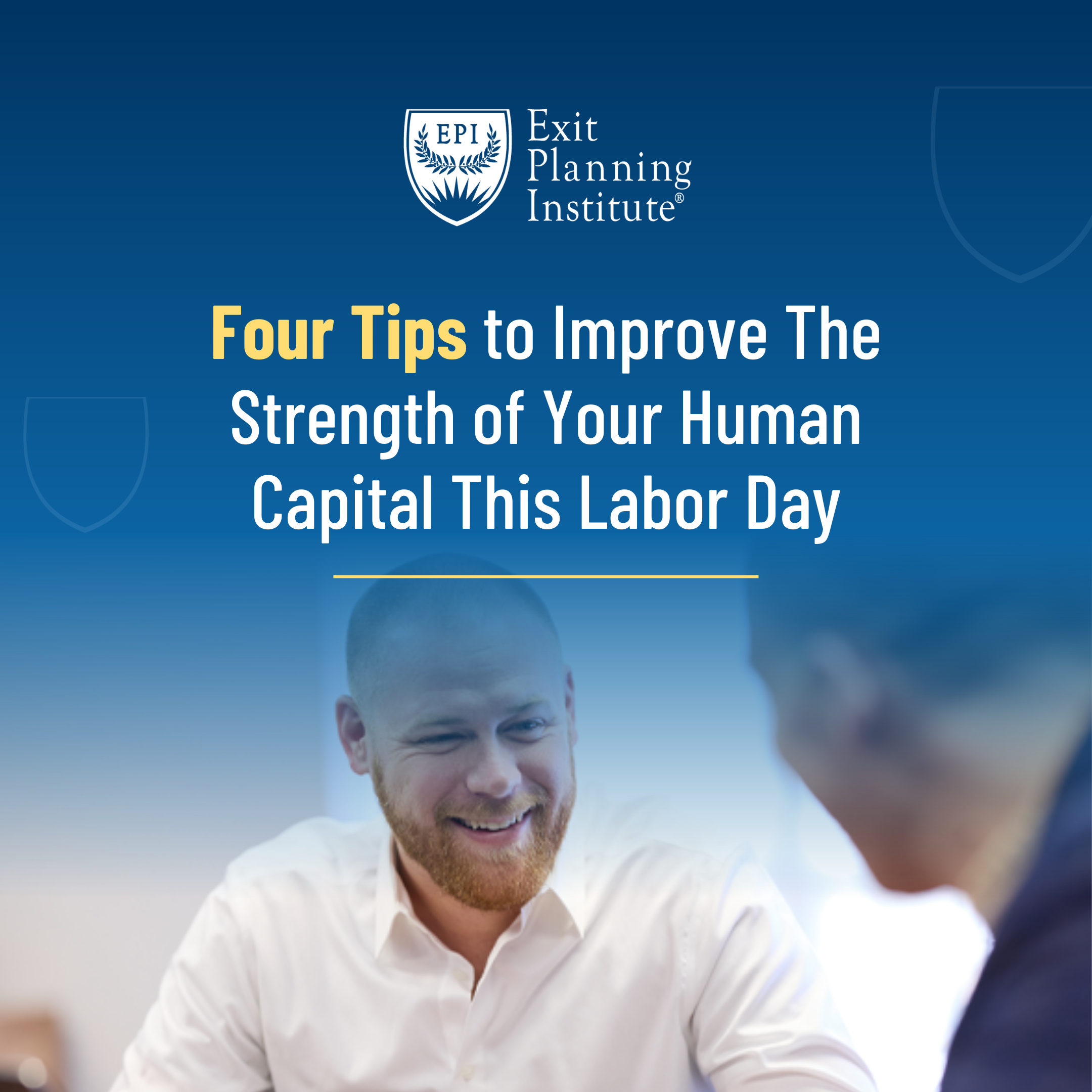
THE EXIT PLANNING BLOG
Keep up-to-date with exit planning, succession planning, industry trends, unique specialty insights, and useful content for professional advisors and business owners.
Share this
Four Tips to Improve The Strength of Your Human Capital This Labor Day
by Colleen Kowalski on September 4, 2023

According to Christopher Snider’s newly released second edition of Walking to Destiny, 80% of a business’s value is tied to its intellectual or intangible capital. He continues to say, “Managing intellectual knowledge has become the single most important task of business. Wealth is built by your ability to create, assemble, integrate, protect, and exploit knowledge assets.”
These intangible capitals are split into four categories: Customer, Social, Structural, and Human Capital. Human Capital is the measure of the strength of your people. It includes your ability to execute tasks, prioritize and innovate in your operations, and deploy key initiatives independently of the owner.
As we celebrate Labor Day and provide our team with the day off, we thought we would share four tips to improve the strength of Human Capital in your business.
Recruit Top Talent
Building a strong Human Capital foundation begins with attracting the best talent available. Consider what you are doing to ensure that your company is an attractive destination for top professionals. Analyze your recruitment strategies, job postings, and company culture. Do they resonate with best-in-class talent? To strengthen your Human Capital, you must first bring exceptional individuals on board.
Start by revisiting your hiring processes. Look beyond qualifications and experience and assess candidates' potential to grow, adapt, and innovate. Create a workplace that values diversity and fosters an environment where talented individuals can thrive.
Motivate and Incentivize Your Team
Motivation is critical for a team to perform at its best. Recognize that financial compensation, while important, is just one aspect of motivation. To truly engage your workforce, develop a comprehensive incentive and recognition program. This could include bonuses, promotions, awards, and non-monetary benefits like flexible working arrangements, professional development opportunities, or wellness initiatives.
Regular feedback and constructive performance evaluations are equally critical. By providing a clear path for career growth and offering continuous learning opportunities, you will not only motivate your team but also enhance their skills and capabilities, contributing to the overall strength of your Human Capital.
Retain High Performers
Employee turnover can be a costly setback for any organization. High-performing employees often have the potential to drive significant value for your business. Losing them not only disrupts operations but also erodes the Human Capital you have invested in. Focus on creating a supportive and inclusive work environment to retain your top talent.
Implement strategies such as mentorship programs, leadership development initiatives, and career progression pathways. Show appreciation for their contributions and offer opportunities for skill expansion. When employees feel valued and see a future within the organization, they are more likely to stay committed and engaged.
Evolve Your Team As Your Business Evolves
In today's dynamic business landscape, adaptation is key to survival. Your Human Capital must be adaptable too. As your business grows and evolves, ensure that your team's skill set and expertise grow with it. Invest in continuous training and development programs that align with your company's changing needs and goals.
Encourage a culture of learning and innovation. Empower your employees to take ownership of their professional growth. By nurturing a culture of adaptation and providing the necessary resources, you'll have a workforce that can readily respond to industry shifts and emerging challenges.
Celebrating Labor Day is not just about acknowledging the workforce but also recognizing the potential and strength of your Human Capital. By recruiting top talent, motivating your team, retaining high performers, and evolving your workforce alongside your business, your team, and your business value will continue to improve. See how EPI has improved our Human Capital in our company in our Case Study.
Share this
- Blog (546)
- CEPA (424)
- exit planning (249)
- CEPA community (187)
- Business Owner (172)
- Exit Planning Summit (97)
- EPI Chapter Network (89)
- Value Acceleration Methodology (80)
- Exit Planning Partner Network (76)
- EPI Announcement (49)
- Content (48)
- Webinars (37)
- Excellence in Exit Planning Awards (33)
- Marketing (30)
- 2024 Exit Planning Summit (28)
- 5 Stages of Value Maturity (26)
- Books (24)
- EPI Academy (24)
- EPI Team (22)
- Exit Planning Teams (22)
- Leadership (21)
- 2023 Exit Planning Summit (20)
- family business (20)
- women in business (19)
- Intangible Capital (18)
- Exit Options (17)
- Black Friday (16)
- CPA (15)
- Walking to Destiny (15)
- State of Owner Readiness (14)
- Chapters (13)
- Chris Snider (12)
- National Accounts (12)
- Small business (12)
- charitable intent (12)
- personal planning (12)
- Financial Advisors (11)
- Season of Deals (9)
- 5 Ds (8)
- About us (8)
- Podcast (8)
- Insiders Bash (7)
- Scott Snider (7)
- Christmas (6)
- Exit Planning Content Library (6)
- Case Studies (5)
- Owner Roundtables (5)
- Three Legs of the Stool (5)
- Value Advisors (5)
- financial planning (5)
- Awards (4)
- Circle of Excellence (4)
- Exit & Succession (4)
- Five Ds (4)
- executive training (4)
- EPI Thought Leadership Council (3)
- Owners Forum (3)
- author (3)
- forbes (3)
- DriveValue (2)
- Exit Is Now Podcast (2)
- Peter Christman (2)
- Veteran (2)
- Whitepapers (2)
- Business Owners Forum (1)
- SOOR (1)
- business consultants (1)






